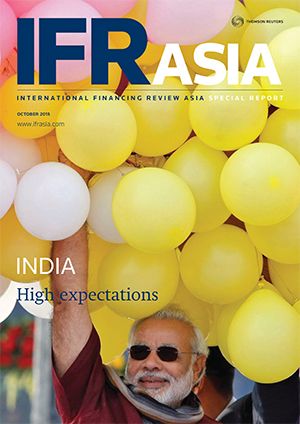Eighteen months into Narendra Modi’s government, things are looking up for India. Growth is quickening, inflation is under control, and reforms are coming through. Harnessing that momentum, however, remains a constant challenge, and India’s prime minister will need to work hard if he is to come close to meeting his grand ambitions.
With growth back up above 7%, India has shrugged off the “fragile five” label that hammered its currency in 2013 and dodged a credit rating downgrade that would have put the sovereign in junk bond territory. Most impressively, it has avoided the vicious volatility and regulatory missteps that sent investors running from China over the summer.
International investors are certainly optimistic, helping drive a bounce in equity underwriting and reopening the moribund IPO market. Assuming the listing of low-cost airline IndiGo closes on schedule, India’s equity capital markets are set for their biggest year in the last decade with over Rs1trn (US$15bn) of stock crossed already this calendar year.
Lured by a pickup in ECM and advisory work – especially in the technology sector – global banks are gradually adding resources once more.
The debt capital markets are benefiting, too. Delhi Airport and Adani Ports showed that good infrastructure assets can be refinanced in the international bond markets, helping take some of the pressure off domestic lenders. Closer to home, wind power developer ReNew Power Ventures set a template for the infrastructure sector with the first rupee bond under an Asian Development Bank-backed credit enhancement scheme.
While domestic reforms have improved liquidity, the most exciting development relates to the use of India’s currency overseas. After allowing the World Bank’s IFC to issue global rupee bonds, India is encouraging local companies to tap foreign investors in their own currency, tweaking offshore borrowing rules to promote the format. Delhi Airport, again, is one of the first on the runway with plans to meet overseas investors.
The world’s biggest democracy doesn’t always move smoothly, and there have been some bumps along the way. Regulations often still create confusion, with little coordination between the finance ministry and tax office, for example.
The initial euphoria that greeted Modi’s election victory in May 2014 has given way to some frustration at the pace of progress. Land reform and bankruptcy laws – both seen as key to restarting the investment cycle – are yet to make it through parliament. Regional elections also threaten to erode Modi’s fragile majority, and could restrict his ability to push through further reforms later in his term in office.
While there is certainly room for disappointment around some of Modi’s grandest ambitions – road projects are a long way short of 30km a day, for instance – India has an enormous opportunity to build on its momentum. Modi is right to be looking up.
To view all special report articles please click here and to see the digital version of this report please click here.
To purchase printed copies or a PDF of this report, please email gloria.balbastro@thomsonreuters.com.
